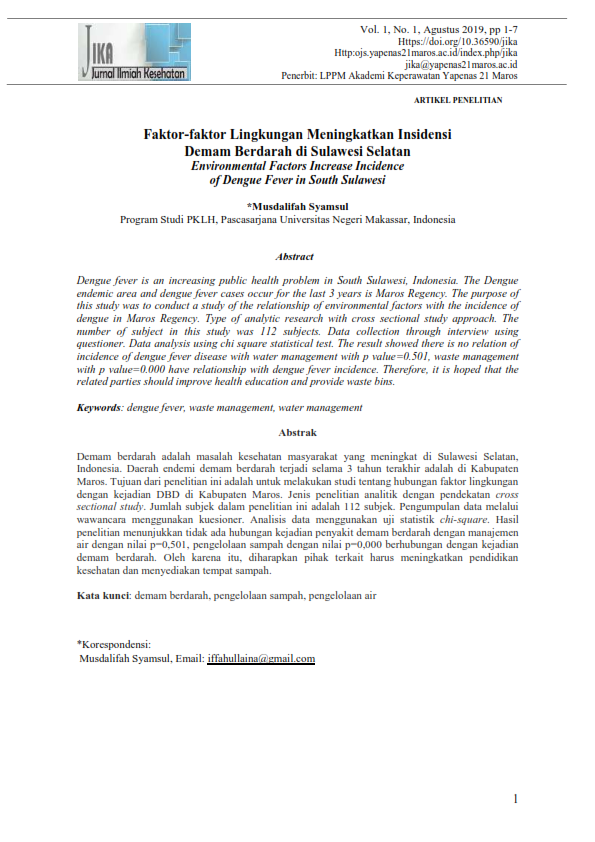Environmental Factors Increase Incidence of Dengue Fever in South Sulawesi
DOI:
https://doi.org/10.36590/jika.v1i1.3Keywords:
dengue fever, waste management, water managementAbstract
Dengue fever is an increasing public health problem in South Sulawesi, Indonesia. The Dengue endemic area and dengue fever cases occur for the last 3 years is Maros Regency. The purpose of this study was to conduct a study of the relationship of environmental factors with the incidence of dengue in Maros Regency. Type of analytic research with cross sectional study approach. The number of subject in this study was 112 subjects. Data collection through interview using questioner. Data analysis using chi square statistical test. The result showed there is no relation of incidence of dengue fever disease with water management with p value=0.501, waste management with p value=0.000 have relationship with dengue fever incidence. Therefore, it is hoped that the related parties should improve health education and provide waste bins.
Downloads
References
Adogu POU, Uwakwe KA, Egenti NB, Okwuoha AP, Nkwocha IB. 2015. Assessment of waste management practices among residents of Owerri Municipal Imo State Nigeria. Journal of environmental protection. 6(5):446.
Banerjee S, Aditya G, Saha GK. 2015. Household wastes as larval habitats of dengue vectors: comparison between urban and rural areas of Kolkata, India. PloS one. 10(10), e0138082
Depkes RI. 2016. Profil Kesehatan Indonesia
Demelle E, Hagenlocher M, Kienberger S, Casas I. 2016. A spatial model of socioeconomic and environmental determinants of dengue fever in Cali, Colombia. Acta tropica. 164:169-176.
Kajeguka DC, Msonga M, Schiøler KL, Meyrowitsch DW, Syrianou P, Tenu F, Kavishe RA. 2017. Individual and environmental risk factors for dengue and chikungunya seropositivity in North-Eastern Tanzania. Infection, disease & health. 22(2):65-76.
Notoatmojo S. 2007. Ilmu Kesehatan Masyarakat, Cetakan 1. Jakarta: Rineka Cipta.
Nuntaboot K, Wiliyanarti PF. 2017. Community social capital on fighting dengue fever in sub urban Surabaya, Indonesia: A qualitative study. International journal of nursing sciences. 4(4): 374-377.
Obionu CN. 2007. Primary health care for developing countries. Second edition. Institute for Development Studies UNEC. Enugu. p221
Kantor Dinas Kesehatan. 2015. Profil Kesehatan Kabupaten Maros.
Quintero J, Carrasquilla G, Suárez R., González C, Olano VA. 2009. An ecosystemic approach to evaluating ecological, socioeconomic and group dynamics affecting the prevalence of Aedes aegypti in two Colombian towns. Cadernos de Saúde Pública. 25: s93-s103.
Sugiyono P. 2015. Metode penelitian kombinasi (mixed methods). Bandung: Alfabeta.
Sutherst R. W. 2004. Global change and human vulnerability to vector-borne diseases. clinical microbiology reviews. 17(1):136-173.
Tana S, Umniyati S, Petzold M, Kroeger A, Sommerfeld J. 2012. Building and analyzing an innovative community-centered dengue-ecosystem management intervention in Yogyakarta, Indonesia. Pathogens and global health. 106(8): 469-478.
WHO [World Health Organization]. 2011. Comprehensive guidelines for prevention and control of dengue and dengue haemorrhagic fever.

Downloads
Published
How to Cite
Issue
Section
License
Copyright (c) 2019 Musdalifah Syamsul

This work is licensed under a Creative Commons Attribution 4.0 International License.








